An openwork knitted blouse is an indispensable element of a woman's wardrobe. A huge selection of yarn and patterns provides a variety of models. Patterns and descriptions of drawings allow you to choose a product for every taste.
To knit a beautiful openwork blouse yourself, you don't have to have a lot of experience and knowledge. With a good combination, a stylish thing can be easily made with a simple pattern from regular yarn. An openwork blouse, as an element of women's clothing, has many advantages over a factory product.
So, a product knitted with knitting needles by hand:
- fits perfectly;
- the sweater is knitted from the selected type of yarn, the color, pattern and silhouette of the product depends only on the knitter’s wishes;
- is subject to any changes - elements can be removed or added according to your taste.
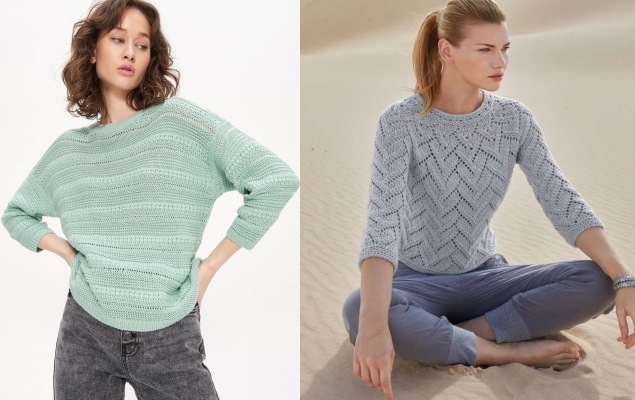
There are models for all ages, body types and seasons.
The process of knitting an openwork blouse varies according to:
- Form. Models come with or without sleeves, with a collar or with a high-quality finished neckline. The length of the product also varies. It depends on the taste of the owner and the purpose of the blouse.
- Style. This can be a classic option for any occasion and time of day or a creative one-of-a-kind model.
- Bloom. Openwork blouses are knitted from yarn of any shade. Single-color and multi-colored models look equally good. A successful option is a combination of different tones of the same color.
- Knitting techniques. When creating an openwork sweater, any method of working with knitting needles is appropriate, for example, connecting fragments of threads of different thicknesses.
- Combination of patterns. Not only delicate openwork patterns are suitable, but also a mesh with holes of any size.
Another important aspect is the design of the finished product. Modern fashion allows the needlewoman to combine the incompatible. Therefore, everything is used, from inserts of various materials to buttons, buckles or fasteners of any shape and color.
The process of making an openwork sweater with knitting needles depends on the chosen pattern scheme and step-by-step description of the work. However, there are basic steps that should be followed for any item.
| Stage | Execution |
| Select a model, material, tool, diagram. | Decide on the appearance of the blouse - choose the design and color of the model. Find a pattern you like with a clear and detailed description. Select yarn and knitting needles. |
| Create a basic pattern for a blouse. | Take measurements.
Create a drawing or find a template for your size. |
| Calculate knitting density. | Knit a fabric from a repeating fragment of a pattern (rapport).
Calculate the number of loops for the cast-on row. |
| Get started. | Cast on stitches for the first row.
Knit according to the description, keeping to the dimensions of the pattern. |
| Finish knitting. | Steam each piece.
Sew the front and back, sew in the sleeves. If necessary, treat the neckline, the bottom of the sleeves and the blouse. |
Main abbreviations in the text: loop, loops – p., row, rows – r. Below is a description of popular models.
Openwork bolero jacket
An openwork knitted blouse, the pattern and description of which differ from the classic method of knitting such clothes, can be made in the "bolero" style. In addition to its functional purpose, the shortened blouse carries a decorative load. The bolero model can be varied to suit your taste.
It is easy to add to the standard form:
- original collar;
- shuttlecock-binding;
- beautiful buttons;
- sleeve of any configuration.
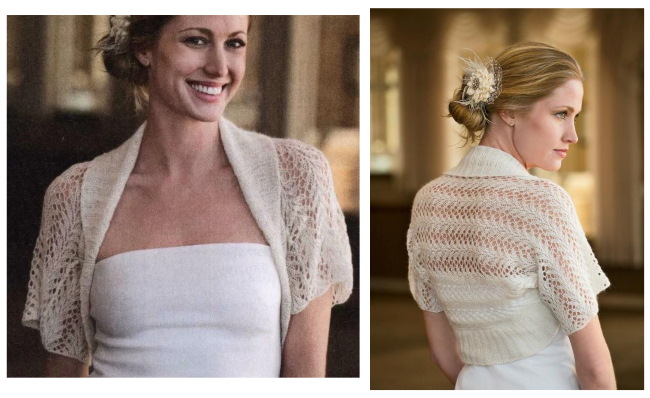
For example, a description of a summer cape with a delicate openwork pattern and a shawl collar. The model is suitable for sizes from S to XXL.
Materials and tools
You need to take a mixed yarn to keep its shape. For the product, 100 g of thread with parameters 50 g / 398 m will be enough. You will need 2 copies of circular knitting needles No. 4.5, but of different lengths - 60 cm and 80 cm. Also, for high-quality work, you need a marker.
Pattern and cutout
The diagram shows the front rows, the back rows, and how the loops look. The pattern rapport shifts slightly during work, which gives the appearance of an openwork diagonal. The pattern shows the values for all sizes in ascending order. For example, if you need size S, you should take the smallest values. The model is knitted across.
Sequence of work
Step by step:
- First, you need to cast on the number of loops on short knitting needles that corresponds to the selected size, taking into account the knitting density.
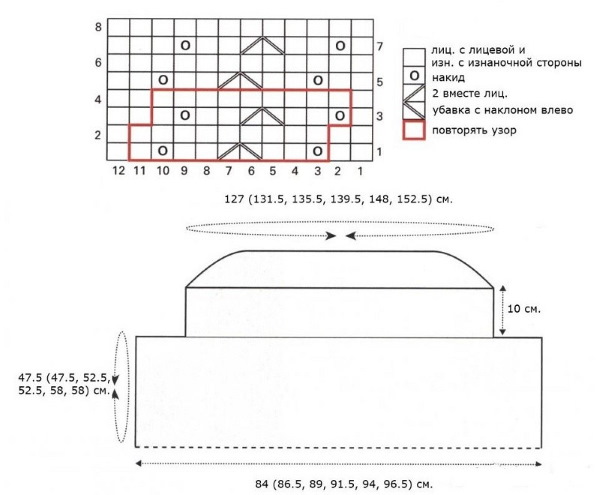
- Next you will need to knit a rectangle, the height of which also corresponds to the size.
- The fabric should be finished with 4 rows of openwork pattern.
Assembly
On both sides of the fabric, you need to make seams for the sleeves, 10 cm long. Then you should start with the binding, which serves as a decorative collar. On 80 cm long knitting needles, you need to cast on 240 sts (size S) along the long side of the fabric.
Place a marker (M) at the beginning of the row and switch to circular knitting. First, knit 3 cm with a 1 l x 2 purl rib, then it is recommended to switch to short needles (60 cm).
Continue knitting in the round, but now use shortened rows:
- You should knit a rib band to the last 4 sts before M, then wrap the loop with thread, turn the work, rib 2x2 to the last 4 sts before M, wrap another loop, turn.
- The elastic band needs to be knitted to the last 3 sts, then wrap the loop, turn, continue the row to the last 3 sts, wrap, turn.
It is necessary to repeat the 2nd row 6 times. The wrapping thread must be knitted together with the loop that was wrapped in the front row with a loop, in the back row - purl. Now it remains to make an elastic band on all sts up to M to a height of 1.5 cm and close all sts in one row.
Openwork blouse with sleeves
Openwork knitted sweater, the diagram and description of which will be clear even to an inexperienced craftswoman. When working, 2 patterns are used - front surface (front rows - front sts, back rows - back sts) and an openwork pattern (according to the diagram).
Description of the model of an openwork sweater knitted with a simple pattern:
- The back and front are knitted without elastic. The shape is straight and not tight.
- The sleeve is long and set-in. Knitted evenly.
- The neck is oval-shaped, without a collar. Finished with piping using a crochet hook.
- All details are knitted with openwork.
Materials and tools – Adela BRILLIANT yarn 100m/50g 350g, straight knitting needles No. 7, hook No. 5. Blouse size 44/46.
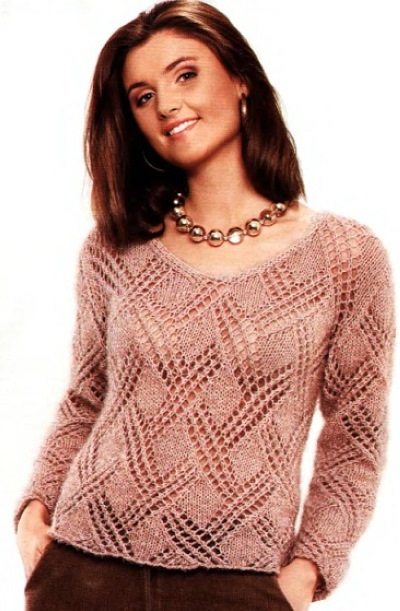
To construct a pattern, you need to take measurements:
- length of the product, sleeve, shoulder, front to armhole;
- half-girth of hips, chest, neck, sleeve;
- depth of cut.
If you don’t have the ability or experience to create a drawing, you can use a ready-made template of the required size.
Back
The first part to knit is the back. You need to cast on 68 sts, then distribute them as follows: 4 sts face stocking stitch, 60 sts openwork pattern, 4 sts face stocking stitch. You should knit exactly 36 cm. Then start shaping the armhole.
Decreases are made in every 2nd row. The first decrease consists of 3 sts, the second - of 2 sts, the third and fourth - 1 st each. Then you should continue exactly to the value of 54 cm from the cast-on edge, then you need to start shaping the neckline.
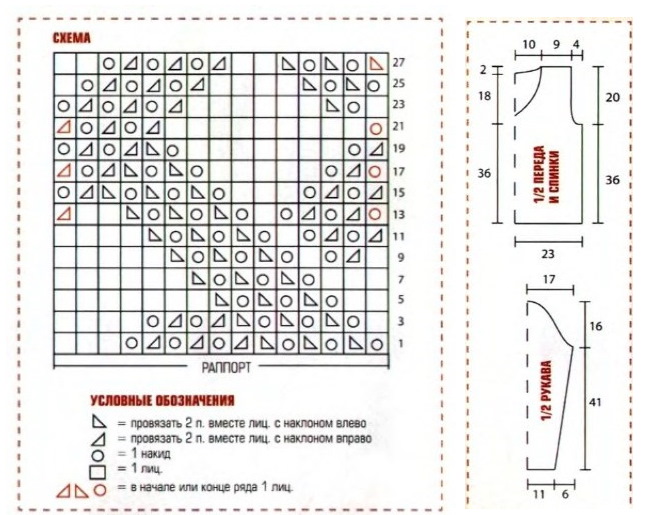
First, in one row, you need to close the middle 12 sts at once, then make roundings on both sides. In every 2nd row, remove 3 sts 1 time, 2 sts 1 time, and then 1 st. At the 56 cm mark from the initial row, you need to finish the work.
Before
The entire process of knitting the front fabric is no different from the back. The only difference is the V-neck, which is done a little differently. At a height of 36 cm from the cast-on edge, you need to divide the loops in half.
Both sides from the middle should be knitted separately. To form the neckline bevel, you will need to close 12 times by 1 st. every other row. When 56 cm of fabric is knitted, you should close the shoulder loops.
Sleeves
There are 2 work options that are equally good. You can first knit one sleeve of the openwork blouse, and then the second in mirror image. Or you can save time - cast on loops for both sleeves at once and knit them simultaneously. This makes it easier to avoid mistakes and make decreases or increases on two parts at once.
For each sleeve, cast on 32 sts and continue knitting with an openwork pattern. To expand the piece, add 1 st on both sides. The total number of increases is 14, rhythmically in every 6th row. At a distance of 41 cm, you need to start shaping the armhole.
To do this, you will need to make decreases on both sides of the knitted fabric. The sequence is 3 sts, then in every 2nd row 2 times 2 sts, 10 times 1 st, 2 times 2 sts, 1 time 3 sts. At the 57 cm mark, close all the loops.
Assembly
First, you need to sew the seams along the shoulder line, then sew in the sleeves. The next step is to sew the side seams and sleeve seams. It is recommended to crochet the neckline with single crochet stitches 1 row.
Openwork top
The summer version for hot days is best knitted from soft natural yarn Schachenmayr Catania. To make a top of size 44, you need to take 4 skeins of 50 g / 125 m and knitting needles on a cable No. 3.5. The front and back of the product are knitted together without side seams to the armhole line. The openwork pattern is located only on the shelf, the back is made with the front surface.
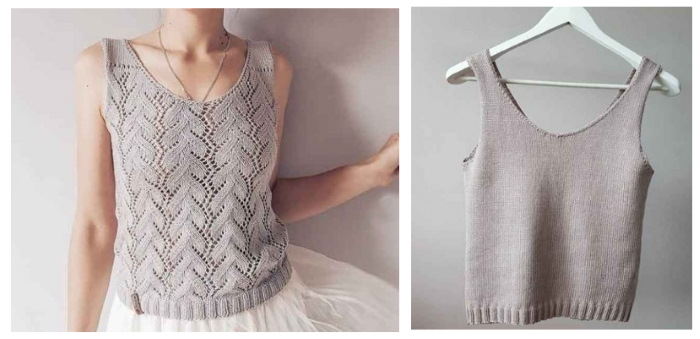
The number of loops for casting on is a multiple of 15+4. If you need to add or subtract loops for size, it is better to knit them as front loops, not including them in the rapport.
Execution algorithm
Description of the work sequence:
- Cast on the initial 188 stitches on the knitting needles and immediately move on to the 2x2 elastic. To do this, alternately knit 2 front sts and 2 out sts. The width of the elastic is 10-12 rows.
- Then you need to move on to the main pattern according to the diagram. The loops on the front and back should be distributed equally - 94 sts each. The front is an openwork pattern, the back is a stocking stitch (front surface). When knitting the last rapport in rows 5, 7, and 9, the last yarn over does not need to be done.
- You need to knit 32 cm in a circle, then you need to divide the fabric into 2 parts (only after knitting an even row).
- Now you should continue the front and back separately in turning rows, making decreases for the armhole and neckline.
- The design of the back and front armholes is done in the same way. Decreases must be done in the front rows. The first time remove 3 sts, the second - 2 sts, then 5 times 1 st. In total, 10 sts should be removed from each side.
- Forming the front neck. You should start decreasing the loops 8 rows after the start of the armhole. The total number of loops will need to be divided in half, then you need to start decreasing from the middle of the fabric.
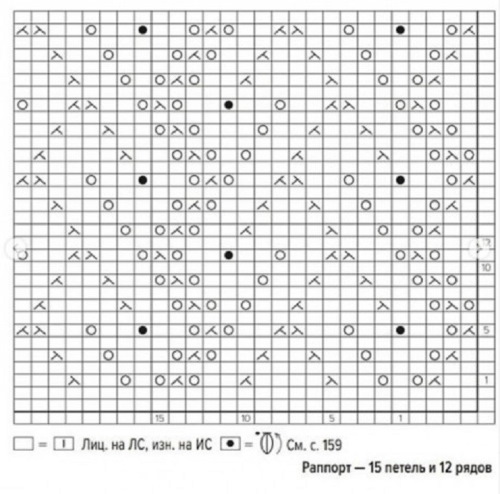
The first time 3 sts, the second 2 sts, the third 2 sts. Then you need to decrease by 1 st until there are 12 sts left. For the second side of the shelf, all actions must be repeated in mirror image.
- The design of the back neckline should be started 12 rows after dividing the circular knitting into 2 pieces. In the middle of the back, the first time you need to remove 4 sts, the second - 3 sts, the third - 2 sts. Then you should continue to remove 1 st until there are 12 sts of the strap left.
- At the armhole height of 12 cm, you should move on to knitting the front straps with the front surface. After 3 rows, you will need to make a strip of "holes" - 2 sts together, 1 yarn over, then continue knitting the strap with the front ones to a height of 22 cm.
The assembly consists of sewing the ends of the straps together and crocheting the neckline. You can replace the edging with ready-made delicate lace, which is carefully sewn onto the knitted fabric.
Openwork summer cotton blouse
To make a beautiful model with short sleeves, you will need cotton yarn, two types of knitting needles - straight and on a cable. For size 40/43, 350 g of yarn (in 50 g 85 m) and knitting needles No. 4.5 are enough. An openwork knitting blouse, the pattern and description of which are very simple, will suit women of any age.

Description of the blouse:
- the product is knitted from the bottom up;
- the back and the shelf are made from separate pieces;
- short raglan sleeve without pattern;
- The neck is edged with an openwork strip.
Front rows according to the pattern, back rows and yarn overs – with back loops (hereinafter referred to as sts). The rapport consists of 12 sts horizontally and 10 rows in height.
Back
You should start knitting from the back. To do this, you need to cast on 87 sts of the first row and immediately start knitting the openwork. The fabric should be even without decreases. At the height of the armhole (36 cm from the first row) is the line for starting decreases along the raglan line.
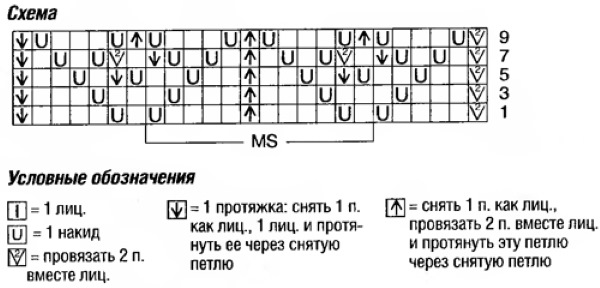
The first time you need to remove 2 sts on both sides, then 1 st through the row, a total of 14 times. When the back length reaches 50 cm, close all the remaining 55 sts.
Before
The next part is the front. For this, you need to cast on 87 sts and continue knitting 36 cm in an openwork pattern according to the diagram. Then you need to start decreasing. They are done in the same way as on the back. The first time 2 sts, then 14 times 1 st through the row. Close 55 sts.
Sleeves
For the sleeve, you need to cast on 64 sts, then switch to garter stitch. This pattern is done in even and odd rows with face loops.
The height of the straight fabric is 3.5 cm, then you will need to start decreasing along the raglan lines:
- first time 2 sts on each side;
- twice 1 st in every second row;
- twice 1 st in each 4 rows.

At a fabric height of 17.5 cm, there should be 32 sts left, which need to be closed. The second sleeve needs to be knitted in exactly the same way. If you have sufficient skill, you can simultaneously cast on loops for both sleeves and knit 2 parts at once.
Assembly
The assembly consists of sewing the finished parts together with a regular needle. The seam should be neat and the stitches should be even. First of all, you need to sew the raglan lines.
Then, cast on 166 sts along the neckline using circular needles and knit 8 rows:
- garter stitch – 2 rounds;
- face - 2 circles;
- yarn over, 2 sts together - 1 round;
- front - 1 circle;
- garter stitch - 2 rounds.
In the last circle, you need to decrease 24 sts at the same distance from each other, then you need to close 142 sts. The final step is to sew the side parts of the product and sleeves.
Made of mohair
You can knit a blouse for any time of year. The most important quality of the thread is hypoallergenicity. The usual composition of mohair includes up to 83% angora wool, the rest can be made of different materials. For example, silk, acrylic or sheep wool.
There are three types of mohair yarn:
- Kid Mohair;
- Gatling;
- Adult Mohair.
For an openwork pattern, Kid Mohair with a delicate and thin thread is suitable. To knit a size 46 model for winter and autumn, you will need to choose a yarn of warm tones. For example, muted red, yellow or orange, light brown, beige.
Tools and pattern selection
The quality of the needles determines the clarity and uniformity of knitting. Needles should be smooth with moderately sharp ends. It is best to refer to the needle selection table or follow the manufacturers' recommendations.
The tension of the thread during the work should be uniform and constant, otherwise the openwork mohair sweater will turn out loose and stretched. At the same time, mohair does not like tight knitting. Therefore, you can take knitting needles one number larger, so as not to tighten the thread. The shape of the tool depends on the model.
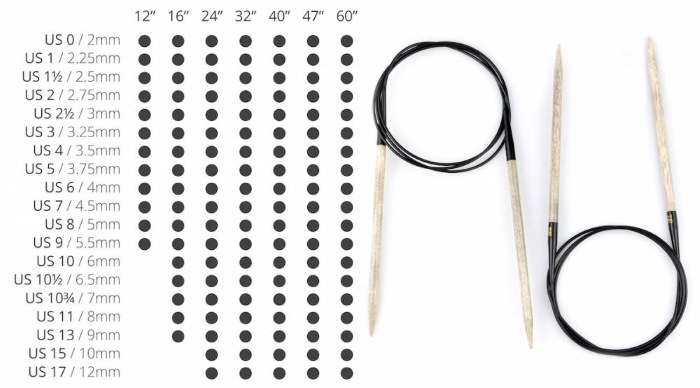
Circular needles are suitable for a seamless sweater, while straight needles are needed when knitting parts of the product separately. The optimal material is bamboo or wood, as mohair does not slip on them. This is convenient for beginner needlewomen.
Before starting work, it is necessary to knit a small fragment of the pattern. This is recommended to determine the correct choice of yarn and knitting needle diameter.
Main stages
To ensure that the product fits well, you need a pattern.
To construct the drawing, you will need to take measurements. Basic measurements:
- half-girth of the neck, chest, arm, wrist, waist, hips;
- chest and back width:
- length of shoulder, sleeve, entire product, back to waist.
You can make a pattern on thick paper yourself. The second option is to select a ready-made template based on the measurements taken.
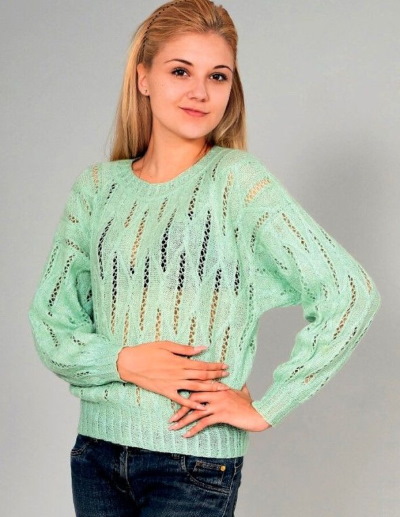
The next step is to knit a fragment of the pattern to calculate the knitting density:
- cast on the number of stitches of the rapport;
- perform rows until it is completed;
- align the sample well;
- measure the height and length of the canvas;
- calculate the number of loops and rows in 1 cm of fabric.
It is necessary to calculate the number of loops for the first row. To do this, multiply the number of loops in 1 cm by the value of the half-girth of the hips.
Algorithm of work
The openwork knitted sweater, the knitting pattern and description of which are presented below, has the following parameters:
- the product is knitted from the bottom up;
- the back and the shelf are made separately;
- sleeves are wrist length, armhole is straight;
- collar missing;
- The neckline, bottom and sleeves are finished with elastic.
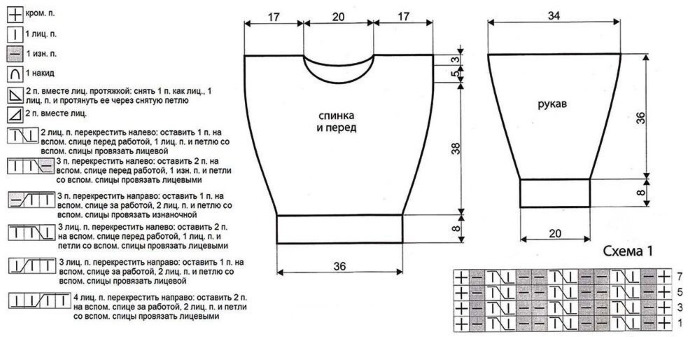
Pattern #1 is the elastic pattern. Pattern #2 is the main pattern. You need to start knitting from the back.
Back
The initial row is 90 sts, you should knit 8 cm with a pattern according to diagram No. 1. In the last row, you need to add 52 sts evenly across the entire fabric. Then you need to knit according to diagram No. 2. After 51 cm, you need to start shaping the neckline.
First, you need to close the middle 46 sts, then you need to make roundings separately on each side. The decreases should be repeated in every 2nd row. The first time 3 sts, the second - 2 sts, the third time - 1 st, then continue knitting evenly. At a height of 54 cm from the cast-on row, you need to close all the loops.
Before
The difference between the knitting process of the front and the back is in the design of a deeper neckline. It should be started at a height of 46 cm from the initial row. After closing the middle 46 sts, continue decreasing along the inner edges of the rounding in every 2nd row.
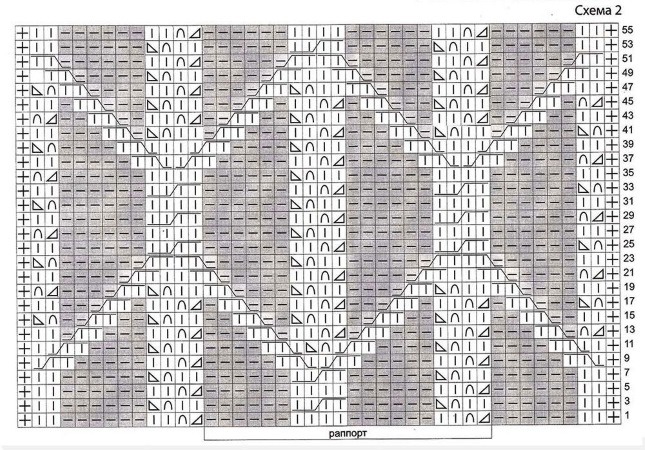
The first time 3 sts, the second – 2 sts, the third – 1 st. At a height of 54 cm, it is necessary to close the remaining shoulder loops.
Sleeves
The initial row is 42 sts, knit 8 cm according to pattern No. 1, then add 40 sts. Continue working, adding 1 st on each side in every 8th row. At a height of 44 cm, close all the loops.
Assembly
First, you need to connect the seams along the shoulder line, then the sides of the product. Lastly, you need to connect the seams of the sleeves and sew the parts into the armhole. Along the entire edge of the neckline, you should cast on 120 sts (knitting needles on a cable), knit 2 rows of stocking stitch, then 6 cm of pattern according to diagram No. 1 and finish the work by closing the loops.
It is very easy to choose the right style of openwork knitted sweater if you study the patterns and descriptions for them. Some models can be knitted in a very short time, others will require patience and experience. In any case, the new thing will decorate the wardrobe of any woman.
Video about knitting
Openwork sweater with knitting needles:
